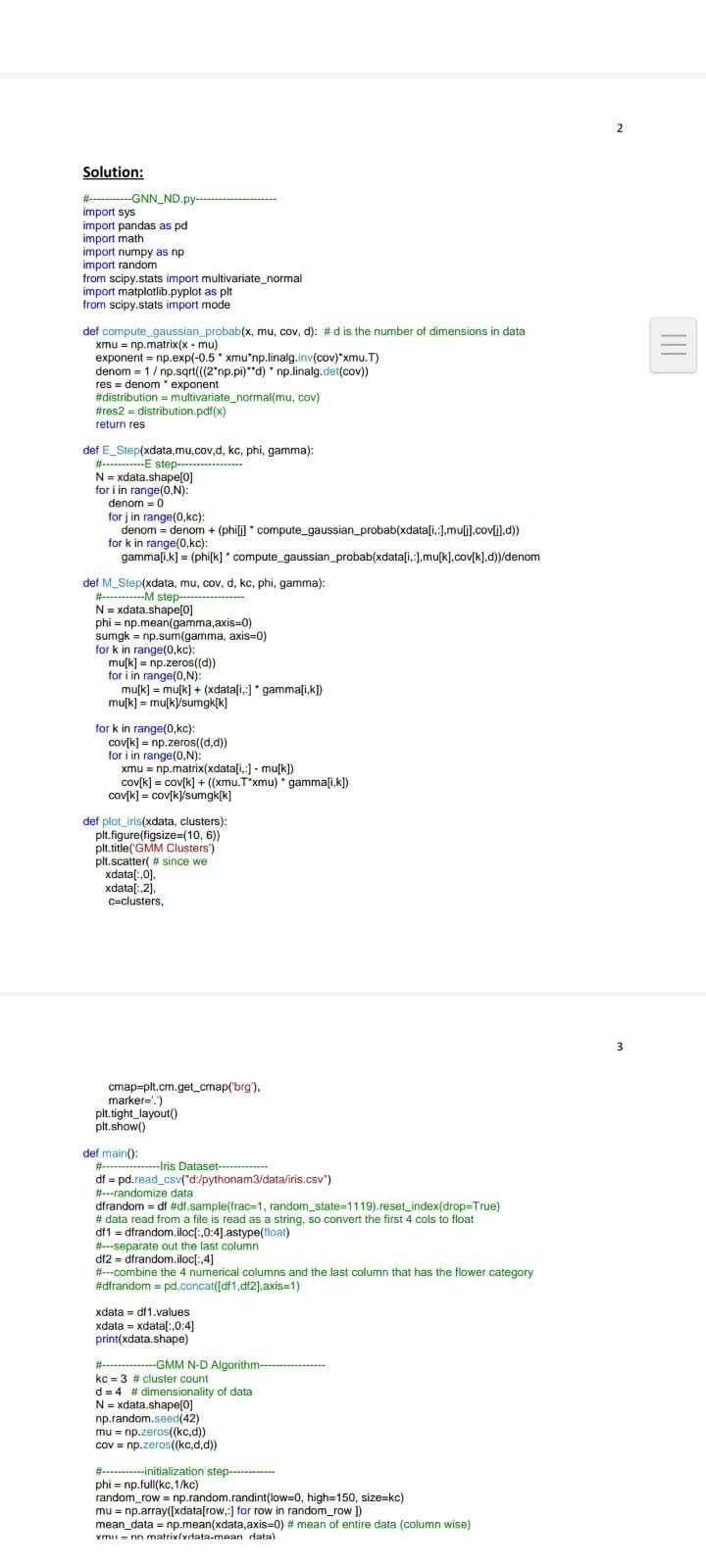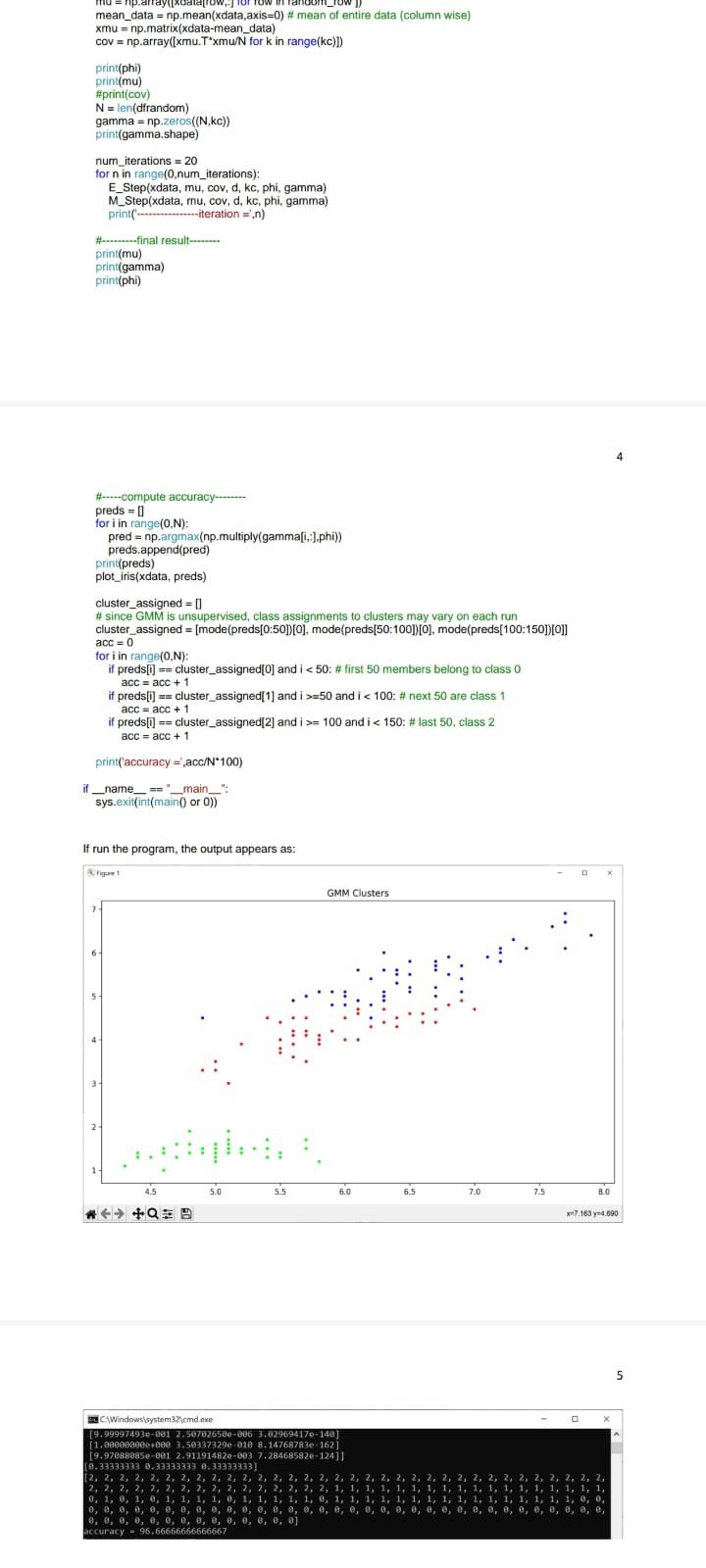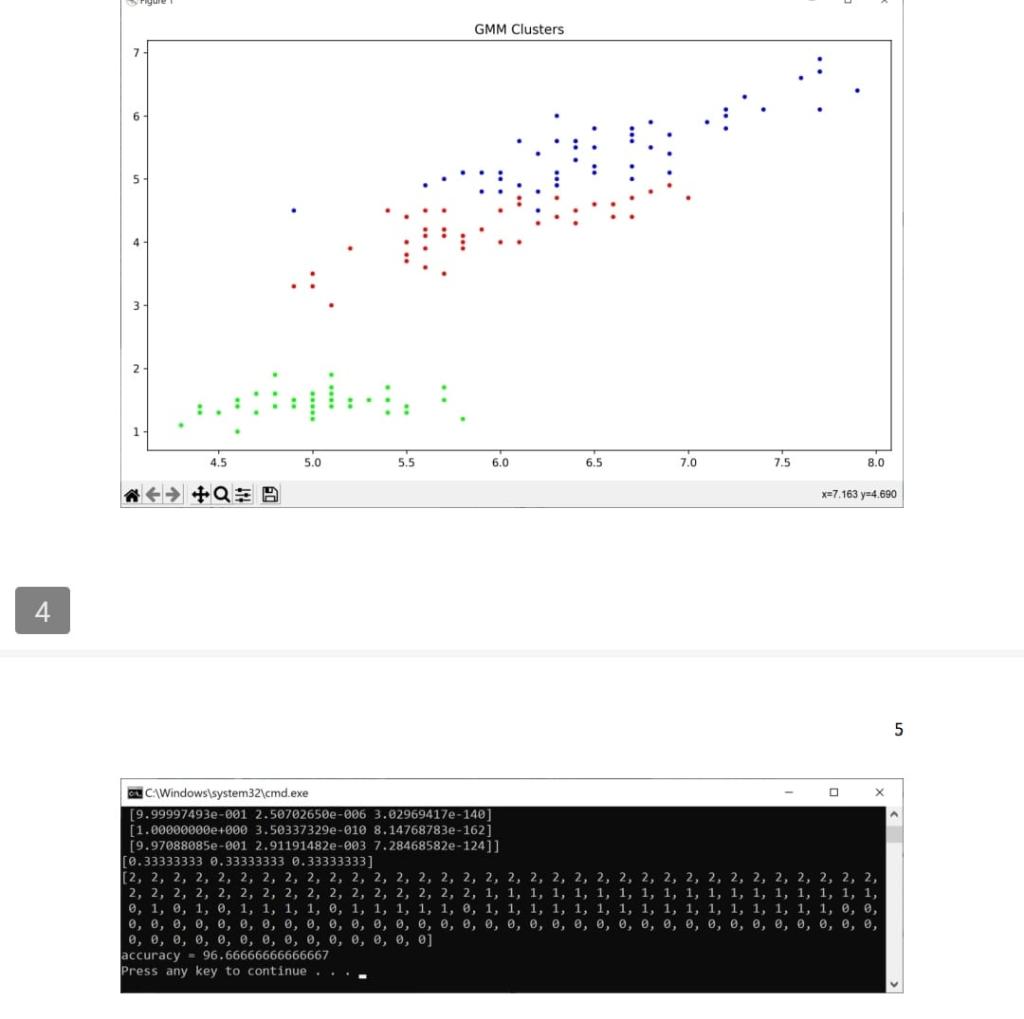

 The code in the given images is implementation og gmm algorithm for iris dataset. With the same implemetation give the entire code for car evaluation dataset. The steps used in the above images should only be used. Give the entire code with output. The output should also get printed as mentioned in the above images. Note: the text values in car evaluation dataset should be converted into numericals
The code in the given images is implementation og gmm algorithm for iris dataset. With the same implemetation give the entire code for car evaluation dataset. The steps used in the above images should only be used. Give the entire code with output. The output should also get printed as mentioned in the above images. Note: the text values in car evaluation dataset should be converted into numericals
Solution: import sys import pandas as pd import math import numpy as np import random from scipy.stats import multivariate_normal import matplotlib.pyplot as plt from scipy.stats import mode def compute gaussian_probab (x,mu, cov, d): \# d is the number of dimensions in data xmu=np.matrix (xmu) exponent =np.exp(0.5munp.linalg.inv ( cov mu.T) denom =1p.sqr(((2np.pi))d) np.linalg. det(cov)) res = denom " exponent \#distribution = multivariate_normal(mu, cov) \#res2 = distribution.pdf(x) return res def E_Step(xdata,mu,cov,d, kc, phi, gamma): H*.....-E step- N=xdata.shape[0] for i in range(0,N) denom =0 for j in range (0,kc) : denom = denom + (phi[] compute_gaussian_probab(xdata[i,,],mu[i],cov[i],d)) for k in range (0,kc) : gamma[i,k] = (phi[k] * compute_gaussian_probab (xdata[i,], mu[k],cov[k],d) / denom def M_Slep(xdata, mu, cov, d, kc, phi, gamma): N=xdata shape phi = np.mean (gamma,axis=0) sumgk = np.sum (gamma, axis =0 ) for k in range (0,kc) : mu[k]=np.zeros((d)) for i in range (0,N) : mu[k]=mu[k]+(xdata[i,] gamma[i,k]) for k in range (0,kc) : cov[k]=np.zeros((d,d)) for i in range (0,N) : xmu=np.matrix(xdata[i,j]mu[k]) def plot_iris(xdata, clusters): plt.figure(figsize =(10,6)) plt.title('GMM Clusters') plt.scatter( \# since we x data [:,0], x data [:,2], cmap=plt.crn.get_cmap('brg'), markef =. ') plt.tight_layout() plt.show() def main(): df = pd.read_csv("d/pythonam3/data/iris.csv") H.-randomize data dfrandom = di \#df.sample(trac=1, random_state =1119 ).reset_index(drop=True) \# data read from a file is read as a string, so convert the first 4 cols to float df1 = dfrandom. iloc[: 0:4].astype(tioat) \#--separate out the last column di2 = dfrandom. iloc [,4] \#--combine the 4 numerical columns and the last column that has the flower category \#dfrandom = pd.concat([df1, di2],axis=1). x data = df1 .values x data =xdata[:,0:4] print(xdata.shape) H-...........GMM N-D Algorithm-.............. kC=3 \# cluster count d=4 \# dimensionality of data N=x data.shape[0] np.random.seed(42) mu=np.2cos((kc,d)) cov=npzeros((kc,d,d)) H.......--initialization step-.......... phi =np. full(kc, 1/kc) random_row =np.random. randint ( low =0, high =150, size =kc) mu=np.array ([xdata[row,;] for row in random_row ]) mean_data =np.mean(xdata,axis=0)# mean of entire data (column wise) rmul = nn matrix(ritata-mean iatal 4 H-.--compute accuracy-..... preds =[] for i in range (0,N) : pred =np.argmax(np.multiply ( gamma[i, ],phi) ) preds.append(pred) print(preds) plot_iris(xdata, preds) cluster_assigned = [] \# since GMM is unsupervised, class assignments to clusters may vary on each run cluster_assigned =[ mode(preds[0:50]) [0], mode(preds[50:100])[0], mode(preds[100:150])[0]] acc =0 for i in range (0,N) : if preds[i] == cluster_assigned[0] and i=50 and i=100 and i


 The code in the given images is implementation og gmm algorithm for iris dataset. With the same implemetation give the entire code for car evaluation dataset. The steps used in the above images should only be used. Give the entire code with output. The output should also get printed as mentioned in the above images. Note: the text values in car evaluation dataset should be converted into numericals
The code in the given images is implementation og gmm algorithm for iris dataset. With the same implemetation give the entire code for car evaluation dataset. The steps used in the above images should only be used. Give the entire code with output. The output should also get printed as mentioned in the above images. Note: the text values in car evaluation dataset should be converted into numericals





